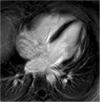Cardiac profile of the Czech population of Duchenne muscular dystrophy patients: a cardiovascular magnetic resonance study with T1 mapping
- PMID: 30626423
- PMCID: PMC6327529
- DOI: 10.1186/s13023-018-0986-0
Cardiac profile of the Czech population of Duchenne muscular dystrophy patients: a cardiovascular magnetic resonance study with T1 mapping
Abstract
Background: The progressive cardiomyopathy that develops in boys with Duchenne and Becker muscular dystrophy (DMD/BMD) is presumed to be a secondary consequence of the fibrosis within the myocardium. There are only limited data on using parametric imaging in these patients. The purpose of this study was to assess native T1 and extracellular volume (ECV) values in DMD patients.
Methods: The Czech population of males with DMD/BMD was screened. All eligible patients fulfilling the inclusion criteria were included. Forty nine males underwent cardiac magnetic resonance (MR) examination including T1 native and post-contrast mapping measurements. One DMD patient and all BMD patients were excluded from statistical analysis. Three groups were compared - Group D1 - DMD patients without late gadolinium enhancement (LGE) (n = 23), Group D2 - DMD patients with LGE (n = 20), and Group C - gender matched controls (n = 13).
Results: Compared to controls, both DMD groups had prolonged T1 native relaxation time. These results are concordant in all 6 segments as well as in global values (1041 ± 31 ms and 1043 ± 37 ms vs. 983 ± 15 ms, both p < 0.05). Group D2 had significantly increased global ECV (0.28 ± 0.044 vs. 0.243 ± 0.013, p < 0.05) and segmental ECV in inferolateral and anterolateral segments in comparison with controls. The results were also significant after adjustment for subjects' age.
Conclusion: DMD males had increased native T1 relaxation time independent of the presence or absence of myocardial fibrosis. Cardiac MR may provide clinically useful information even without contrast media administration.
Keywords: Cardiac magnetic resonance; Cardiomyopathy; Duchene muscular dystrophy; T1 mapping; extracellular volume.
Conflict of interest statement
Authors’ information
Not applicable.
Ethics approval and consent to participate
The study was performed in accordance with the Declaration of Helsinki (2000) of the World Medical Association, and was approved by the institutional ethics committee (University Hospital Brno, reference number 20130410–03). Written informed consent was obtained from the subjects and/or their legally authorized representative.
Consent for publication
No person’s personal data are published.
Competing interests
The authors declare that they have no competing interests.
Publisher’s Note
Springer Nature remains neutral with regard to jurisdictional claims in published maps and institutional affiliations.
Figures




Similar articles
-
Global, segmental and layer specific analysis of myocardial involvement in Duchenne muscular dystrophy by cardiovascular magnetic resonance native T1 mapping.J Cardiovasc Magn Reson. 2021 Oct 14;23(1):110. doi: 10.1186/s12968-021-00802-8. J Cardiovasc Magn Reson. 2021. PMID: 34645467 Free PMC article.
-
T1-Mapping and extracellular volume estimates in pediatric subjects with Duchenne muscular dystrophy and healthy controls at 3T.J Cardiovasc Magn Reson. 2020 Dec 10;22(1):85. doi: 10.1186/s12968-020-00687-z. J Cardiovasc Magn Reson. 2020. PMID: 33302967 Free PMC article.
-
Native T1 values identify myocardial changes and stratify disease severity in patients with Duchenne muscular dystrophy.J Cardiovasc Magn Reson. 2016 Oct 28;18(1):72. doi: 10.1186/s12968-016-0292-8. J Cardiovasc Magn Reson. 2016. PMID: 27788681 Free PMC article.
-
Oedema-fibrosis in Duchenne Muscular Dystrophy: Role of cardiovascular magnetic resonance imaging.Eur J Clin Invest. 2017 Dec;47(12). doi: 10.1111/eci.12843. Epub 2017 Oct 31. Eur J Clin Invest. 2017. PMID: 29027210 Review.
-
Cardiac MRI biomarkers for Duchenne muscular dystrophy.Biomark Med. 2018 Nov;12(11):1271-1289. doi: 10.2217/bmm-2018-0125. Epub 2018 Nov 30. Biomark Med. 2018. PMID: 30499689 Free PMC article. Review.
Cited by
-
Variations in native T1 values in patients with Duchenne muscular dystrophy with and without late gadolinium enhancement.Int J Cardiovasc Imaging. 2021 Feb;37(2):635-642. doi: 10.1007/s10554-020-02031-z. Epub 2020 Sep 20. Int J Cardiovasc Imaging. 2021. PMID: 32951096
-
Global, segmental and layer specific analysis of myocardial involvement in Duchenne muscular dystrophy by cardiovascular magnetic resonance native T1 mapping.J Cardiovasc Magn Reson. 2021 Oct 14;23(1):110. doi: 10.1186/s12968-021-00802-8. J Cardiovasc Magn Reson. 2021. PMID: 34645467 Free PMC article.
-
Cardiovascular progenitor cells and tissue plasticity are reduced in a myocardium affected by Becker muscular dystrophy.Orphanet J Rare Dis. 2020 Mar 5;15(1):65. doi: 10.1186/s13023-019-1257-4. Orphanet J Rare Dis. 2020. PMID: 32138751 Free PMC article.
-
DMD Pluripotent Stem Cell Derived Cardiac Cells Recapitulate in vitro Human Cardiac Pathophysiology.Front Bioeng Biotechnol. 2020 Jun 19;8:535. doi: 10.3389/fbioe.2020.00535. eCollection 2020. Front Bioeng Biotechnol. 2020. PMID: 32656189 Free PMC article.
-
Decreased quality of life in Duchenne muscular disease patients related to functional neurological and cardiac impairment.Front Neurol. 2024 Feb 8;15:1360385. doi: 10.3389/fneur.2024.1360385. eCollection 2024. Front Neurol. 2024. PMID: 38390598 Free PMC article.
References
-
- Aartsma-Rus A, Van Deutekom JC, Fokkema IF, Van Ommen GJ, Den Dunnen JT. Entries in the Leiden Duchenne muscular dystrophy mutation database: an overview of mutation types and paradoxical cases that confirm the reading-frame rule. Muscle Nerve. 2006;34(2):135–144. doi: 10.1002/mus.20586. - DOI - PubMed
Publication types
MeSH terms
Substances
Grants and funding
LinkOut - more resources
Full Text Sources
Medical

